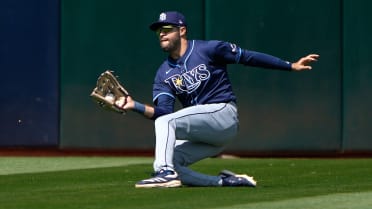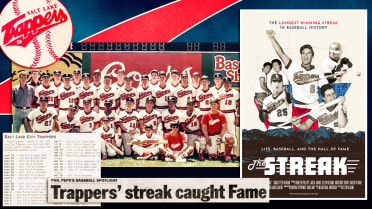Five questions facing Tigers this offseason
DETROIT -- The last time the Tigers headed into an offseason with so much anticipation, they were trying to bolster a roster around Justin Verlander and Miguel Cabrera for one more postseason run. That was the winter of 2015-16, and the Tigers were accustomed to competing for playoffs and World Series.
Fast-forward five years, and the scenario has changed. While Cabrera is still in the middle of the lineup, the core is young, from Casey Mize, Tarik Skubal and Matt Manning in the rotation to Jeimer Candelario at third base to prospects on the way. The Tigers are coming off a fifth consecutive losing season, but a 77-win campaign has Detroit on the upswing.
“Obviously the next goal is to get above .500,” manager A.J. Hinch said. “And then you go as far above .500 as needed to get to the playoffs.”
Some might compare this to the offseason when the Tigers shocked baseball in February 2004 by signing Iván Rodríguez, starting a rise from 119 losses in 2003 to appearing in the World Series three years later. Or maybe it’s better compared with the next offseason, when the Tigers signed Magglio Ordóñez.
Realistically, this team might best be compared to 2005, when Rodriguez and Ordóñez were in place, Curtis Granderson had arrived and Justin Verlander and Joel Zumaya were on the way. The Tigers that offseason made targeted signings rather than a big splash, but their deals for Kenny Rogers and Todd Jones turned out to be keys for their rise to the World Series the next season.
The Tigers are tempering expectations and targeting a gradual rise, but they also want to be opportunistic. Here are five questions they have to answer to get there:
1. Is this the year the Tigers go big into free agency again?
This has been asked or inferred in some form since last spring, when Robbie Grossman signed Detroit’s first multi-year contract for a free agent in five years. The Tigers took another step by signing Jonathan Schoop to a two-year, $15 million extension in August. Even with their deals, the Tigers have their long-awaited payroll flexibility because Cabrera has the only other guaranteed contract on the books.
Add that payroll room to the Tigers’ upward trajectory and the needs they have to fill to take the next step and contend, and Detroit is ready to be a player in free agency for the first time since the 2015-16 offseason. But general manager Al Avila cautioned last week that they won’t be spending wildly just to spend.
“I will caution: This is not going to be spending like a drunken sailor,” Avila said. “This is going to be a very measured process. We’re going to make sure that whatever decisions we make, free agency-wise, that it doesn’t sink this organization for years to come, but it builds this organization for years to come.”
Hinch was nuanced in his explanation, noting that Grossman had the impact of a big splash.
“I know what everybody wants to hear, and how they want to talk about the top end of the market,” Hinch said. “And if that happens, I’ll be the first one up here holding the jersey and loving life and I’ll kiss [Avila] on the cheek. I just think we have to understand what it takes to win. It doesn’t take a big splash to win.”
2. Who will be the shortstop?
This has been the big question regarding the Tigers’ rebuild for a while. This was the year to figure out if Willi Castro was the guy, and while Castro could play a part on a contending Tigers roster, it won’t be at shortstop. Ryan Kreidler emerged as a potential future shortstop with a breakout summer in the farm system, but his upside probably isn’t All-Star level. With the deepest free-agent shortstop class in years, plus other young shortstops potentially available in trades, the Tigers are going to explore.
The natural tie-in is Carlos Correa, who became a star playing for Hinch in Houston, but that in itself won’t be enough for the 27-year-old to put down roots in Detroit. Even if the Tigers are spending this offseason, outspending larger-market teams with interest is another matter. But if the Tigers can’t get Correa, the market is deep enough to present alternatives, from Blue Jays All-Star Marcus Semien to Rockies slugger Trevor Story.
“We’re not going to target one player. We have to look at the whole list of free agents,” Avila said without mentioning names. “And we’ll be in contact with everybody, and then we’ll see where that leads us. … If you target one guy, you can’t be guaranteed you’re going to get that guy, so you have to make sure that you have a wide net.”
3. Who will start besides the three youngsters?
This might have been answered already if not for injuries. Spencer Turnbull underwent Tommy John surgery on his elbow and won’t be back until late next season, if not 2023. Matthew Boyd thankfully avoided Tommy John surgery, but will undergo surgery on his flexor tendon that could sideline him into next season. He’s eligible for arbitration this winter, and Avila has hinted they’ll need to work something out prior to the nontender date.
Even if the Tigers bring back Wily Peralta, who’s eligible for free agency coming off a very good bounceback season, they’re going to have to hit the open market. Avila wants an impact starter to lead the group.
"I would say an established starter would be a necessity," said Avila, who added he considers the starting pitching void as important as their shortstop need.
4. Is Eric Haase the Tigers’ catcher?
Haase became a hometown hero this year with a breakout season for the team he grew up rooting for in Michigan. His 22 home runs were one off Grossman’s team lead, and the most by a Tigers catcher since Mickey Tettleton nearly 30 years ago. However, he faded a bit down the stretch, and his defense was a mixed bag -- his 31-percent caught-stealing rate was good, but his seven passed ball were a bit high.
Haase is definitely a big part of next year’s club, but his ultimate fit might be more like the role he had before Jake Rogers’ season-ending elbow surgery -- splitting catching duties while also getting time in left field and maybe first base. With Rogers expected to miss much of next season, however, the Tigers need a catcher to share some of those starts, whether that involves bringing back veteran backup Dustin Garneau or acquiring someone else. The free-agent catching market is thin.
“That also leaves us an area of concern there,” Avila said.
5. How do Riley Greene and Spencer Torkelson impact the Tigers’ plans?
While the Tigers aren’t talking about the chances of Riley Greene and Spencer Torkelson winning big-league jobs out of Spring Training next year, their two top prospects are close enough that the Tigers can plan next year around having them in Detroit sooner rather than later. Greene’s anticipated arrival means the Tigers are pretty much set in their outfield.
“We feel we’re OK there,” Avila said, adding Greene to a young core that includes Daz Cameron, Derek Hill and Akil Baddoo. “If there’s an opportunity to capitalize on something, maybe we look at it. But right now, it’s not an area of concern.”
Torkelson’s anticipated arrival at first base actually has more of an impact at second base, since Schoop can shift over there once Torkelson arrives.
Senior Reporter Jason Beck has covered the Tigers for MLB.com since 2002.




